FA Laws for Mini-Soccer (5v5 and 7v7)
MINI SOCCER INTRODUCTION
- Children from Under 7 to Under 10 do not play in leagues.
- They can play in a maximum of three trophy events during the season.
- This allows them to learn about winning and losing in a fun environment. Trophies can be awarded to the winners and the results of the mini-event published.
Age Maximum Format Trophy Events
- U7s-U8s: 5 v 5; 3 x 2 weeks in a season
- U9s-U10s: 7 v 7; 3 x 4 weeks in a season
MINI-SOCCER LAWS
1 PLAY PHASE
Childhood is a magical time of infinite possibilities, hope and potential! To help our young children we have developed Play Phase for children age 4-6 as England Football's Early Years philosophy.
The fun of taking part in games while keeping active can make a huge and positive difference that lasts a lifetime. So, let's lag these good foundations early.
Play Phase is about encouraging children in skills and learning that will eventually be useful not just in football, but in life. It makes learning fun, playful and creative, for lifelong benefits.
2 PLAYING AREA
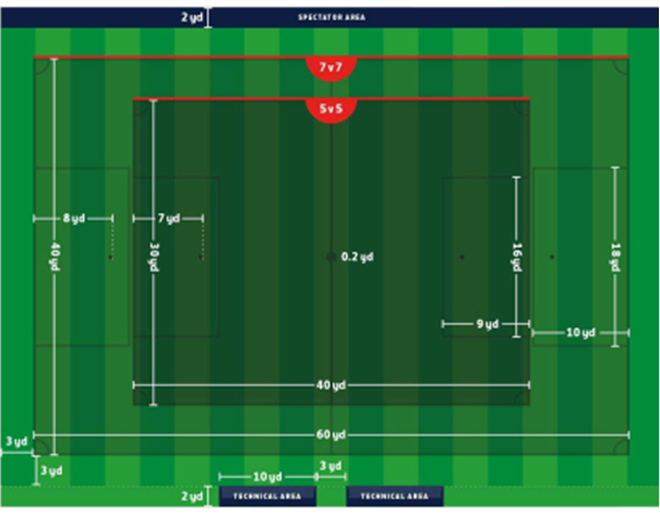
Playing areas are for development football matches for those aged from U7-8 & U9-10.
- Kick offs: these are taken from the centre mark on the half way line.
- Retreat line: the team without the ball moves to the line when goal kicks are taken.
- Goal sizes: the goal size for Mini Soccer is 12ft x 6ft
3 THE BALL
- U7s-U10s should use a size 3 ball.
- The ball should be safe for children to play with and made of leather or another suitable material.
4 NUMBER OF PLAYERS
- U7s-8s: the maximum number of players per team is 5v5 with a squad of 10 or less.
- U9s-10s:the maximum number of players per team is 7v7 with a squad of 14 or less.
- Coaches can be flexible outside of Trophy Events
- The FA is strongly of the opinion that there are technical benefits to be gained by playing formats of the game using smaller numbers such as 4v4, 3v3, 2v2.
- The structure of Development football lends itself to playing in a variety of different competitive formats across the season. Leagues should be flexible with fixtures.
- Reds U7s and Blues U7s, each with 7 registered players, could play a 4v4 and a 3v3 instead of a 5v5 and two substitutes, where facilities allow. The FA recommends that coaches should seek to provide these different challenges.
- Roll-off roll-on substitutions can be made at any time during the game with permission from the referee, including players who have already been substituted.
5 PLAYING EQUIPMENT
- Children cannot play Development Football without shin pads.
- These should be covered entirely by knee length socks.
- Goalkeepers should wear a different coloured shirt to the rest of the team.
- Footwear should be appropriate for the playing surface - no metal studs on 3 and AGP pitches.
- If the weather is poor then players should wear appropriate clothing, but hoodies are not allowed.
6 MATCH OFFICIALS
- Any person who referees a game of Development Football has the authority to apply the Laws of Mini-Soccer even if they are not a fully qualified referee.
- The referee should always help the players to learn the game by explaining their decisions.
- Assistant referees are not required for Development Football.
7 DURATION OF THE GAME
Age maximum playing time in any one day:
- U7s-U8s: 40 minutes
- U9s-U10s: 60 minutes
- Children should not exceed the maximum playing time for their age in ang one day. It is the responsibility of the junior club and/or the child's parent or carer to ensure this.
- Each league is allowed to determine its own playing time up to the maximum allowed.
- Half time should not be more than five minutes.
- Development games can be split into quarters within the maximum playing time allowed.
- For tournament football see the Standard Code of Rules for Youth Competitions.
8 START AND RESTART OF PLAY

- A kick off from the centre mark starts the game, or restarts it after a goal is scored.
- It can be taken in any direction.
- The opposition must be five yards away and in their own half.

- In Mini-Soccer a goal cannot be scored directly from a kick off or a dropped ball.
- In special circumstances a drop ball is used to restart the game, such as after an injury.
- If the game has stopped with the ball in the penalty area, the drop ball should be taken on the penalty area line (pictured).
9 BALL IN AND OUT OF PLAY
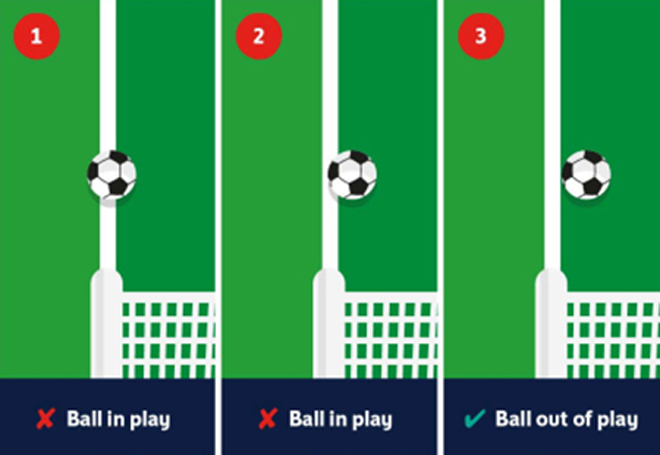
- The goal line and touchlines are part of the field of play. The ball must be entirely over these lines to be out of play (pictured).
- If an attacker is the last player to touch the ball over the goal line, a goal kick is given.
- If a defender is the last player to touch the ball over the goal line, a corner kick is given. If a player touches the ball over the touchline, a “Pass or Dribble-ln” is given to the opposing team.
10 METHOD OF SCORING

- A goal is scored when the ball completely crosses the goal line between the posts and under the crossbar of the goal (pictured).
- If a foul or handball occurs the goal shall be disallowed.
11 OFFSIDE

- There is no offside in Development Football.
- The children can be in any area of the pitch at any time (pictured) apart from when the Retreat Line is played.
12 FOULS AND MISCONDUCT
- Free kicks are awarded when a foul is committed as in older age football.
- In mini soccer all free kicks are direct, except when a deliberate header has occurred.
- A goalkeeper is not allowed to pick the ball up from aback pass or a throw in.
- If this happens a free kick should be given on the penalty area line closest to where the incident occurs.
- For Under7s to Under 9s (2024-25 season) and for Under 7s to Under 10s (2025-26 season); Deliberately heading the ball is on offence punishable by an indirect free kick. The indirect free kick is taken at the point where the ball was deliberately headed, except: Where a player deliberately heads the ball within their own penalty area, the referee will stop the game and restart with an indirect free kick to the opposition from the nearest side line of the penalty area where the offence took place.
- As with all other aspects of Development Football the children should be learning the game. Coaches in training, and referees on the day, should try to make sure the children understand all of the above.
13 FREE KICKS
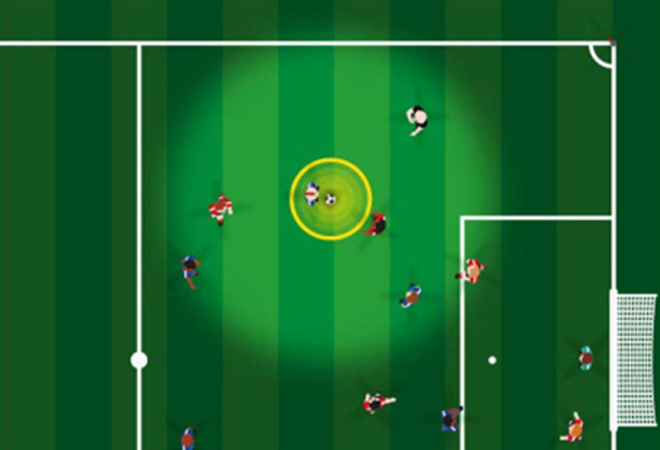
- For all free kicks defending players must be 5 yards from the ball.
14 PENALTY KICKS

- If a foul is committed in the penalty area by a defender a penalty kick will be awarded.
- All players except the defending goalkeeper and kicker must be outside the penalty area and at least 5 yards from the penalty mark.
- The ball must be kicked forward.
15 PASS OR DRIBBLE-IN
U7-U9 (2024-25) and U7-U10 (2025-26)
- When the whole of the ball passes over the touchline, on the ground or in the air, instead of a throw-in, a pass-in or dribble-in is awarded.
- A kicker taking a pass-in may choose to touch the ball again before it is touched by another player
At the moment of delivering the ball:
- The ball must be stationary on the touchline at the point where it left the pitch; only the kicker may be off the pitch.
- All opponents must stand at least 5 yards from the point on the touchline where the pass-in or dribble-in is to be taken.
- A goal cannot be scored directly from a pass-in.
- The ball is in play when it is kicked and clearly moves
U10s only in 2024-25: Normal throw-ins are allowed.
16 GOAL KICKS
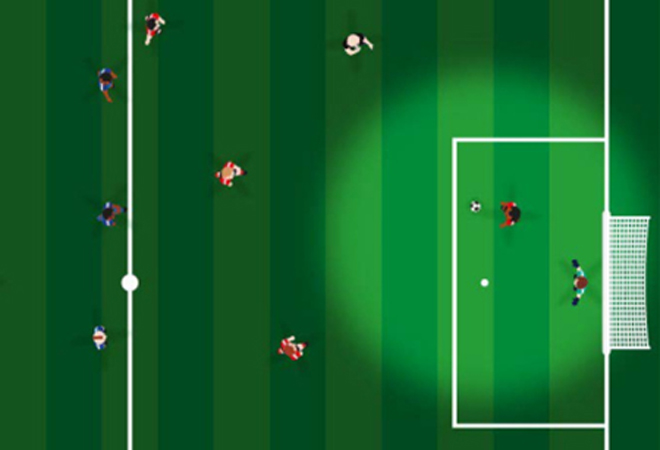
- If an attacking player kicks the ball over the goal line a goal kick is awarded to the defending team.
- A goal kick can be taken from any point within the penalty area and by any player from the team with the ball.
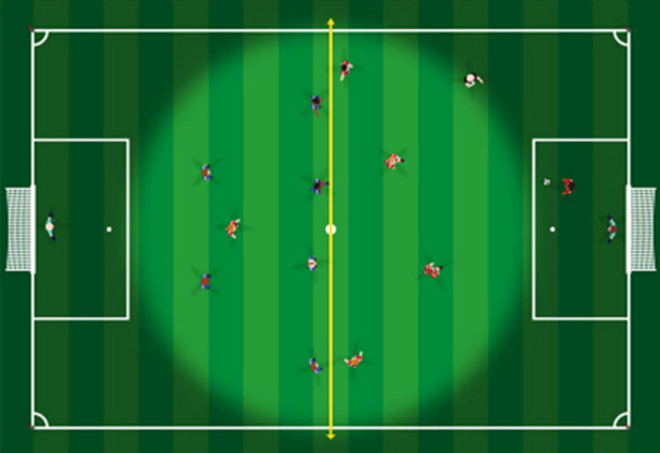
- The team without the ball must retreat to their own half until the ball is in play.
- This is known as the Retreat Line.
- Once the ball is in play, the team without the ball can try and win it back.
- As with all the Laws of Development Football, the referee should help the players learn the game.
17 CORNER KICKS
- If a defending player kicks the ball over the goal line a corner is awarded to the attacking team.
- The defending players must remain at least 5 yards from the ball until it is in play.
- The player taking the corner may not touch the ball again until it has touched another player.
POWER PLAY LAW (Optional)
Development football is designed to create the best learning and fun experience for young players. To ensure an imbalance in ability does not spoil this, the FA has approved “Power Play” as an option that mini-soccer and youth leagues can adopt.
- If a team is losing by a four goal difference they can put an additional player on - so 5v5 becomes 6v5.
- If the score returns to less than a four goal difference the team takes off a player. It does not have to be the last player to come on.
- If a team goes on to be losing by a six goal difference a further additional player can be added - so 6v5 becomes 7v5.
- The main aim of the Power Play option is that all players are being challenged and enjoying the game.
- Power Play is available through all mini soccer football formats 5v5 and 7v7.
|
Score |
What happens? |
5 v 5 |
7 v 7 |
|
Red team 3-0 Blue team |
No change |
5 v 5 |
7 v 7 |
|
Red team 4-0 Blue team |
Blue team brings on one extra player |
5 v 6 |
7 v 8 |
|
Red team 4-1 Blue team |
Blue team removes one player* |
5 v 5 |
7 v 7 |
|
Red team 5-1 Blue team |
Blue team brings on one extra player |
5 v 6 |
7 v 8 |
|
Red team 6-1 Blue team |
No change |
5 v 6 |
7 v 8 |
|
Red team 7-1 Blue team |
Blue team brings on another extra player |
5 v 7 |
7 v 9 |
|
Red team 7-2 Blue team |
Blue team removes one player* |
5 v 6 |
7 v 8 |
|
Red team 7-3 Blue team |
No change |
5 v 6 |
7 v 8 |
|
Red team 7-4 Blue team |
Blue team removes one player* |
5 v 5 |
7 v 7 |
* This does not need to be the same player that was put on as the additional player
Previous page: DCSFA Primary and Competition Rules
Next page: FA Laws for 9 v 9 Football
